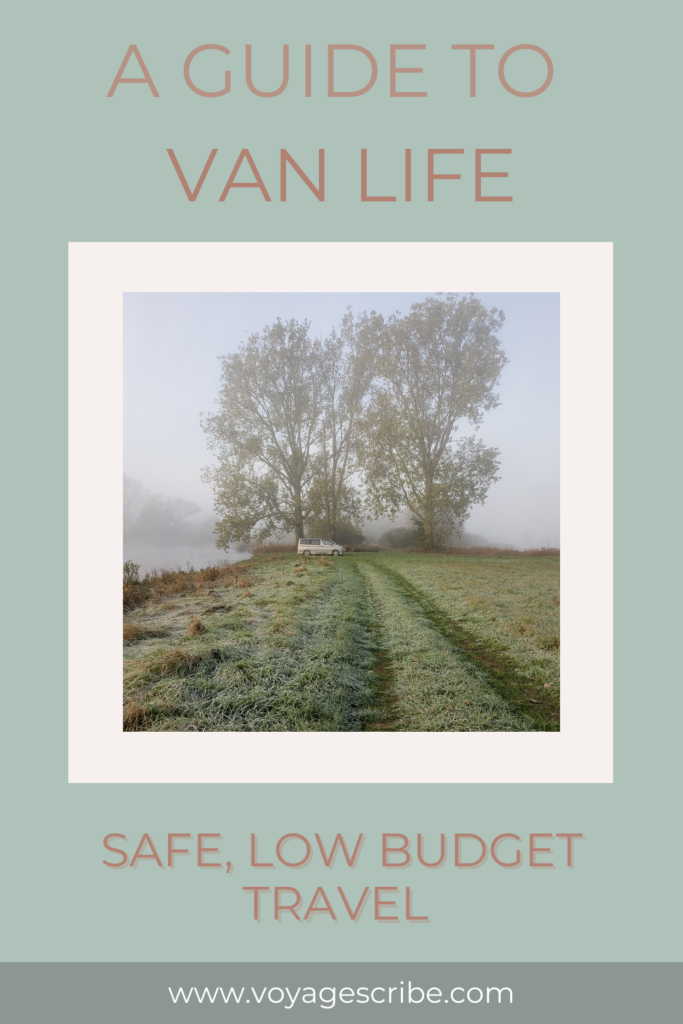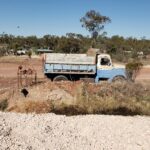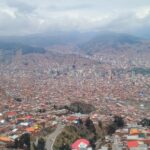Van life became all the rage when COVID shut down borders. With international travel out of the question, people turned to local tourism and road trips more than ever. I had big worldwide travel plans last year, but like everyone else had to improvise. Instead, I decided to travel around the UK and Poland by van. And now I’m sharing all I learned from our experience in this guide to traveling by van on a low budget– and with minimal conversion!
While we had a van, it wasn’t one of those fancy, converted ones you see on Instagram, complete with a bathroom, kitchen and living room. The only conversion it had was a bed platform with the back seats taken out. This allowed us to store stuff under the bed.

But if you can’t (for example, you’re renting or borrowing a van) or don’t want to do this, you can do it *super* low budget and low effort by just laying down the back seats and throwing in a mattress. Not the most comfortable, and you won’t fit much stuff in, but it does the job, especially for shorter road trips.
And you don’t even need a van. Depending on how many people you’re traveling with, you can make it work with any medium to large sized car. I’ve slept in the back of a Toyota Highlander before, and doing it more long-term would definitely be doable. (And might be done by me this summer.)
But since we didn’t have a fancy converted van, I thought I’d share how you can also travel by van on a super low budget and with minimal to no conversion, and how to do it safely during COVID.
(This post contains affiliate links.)
Table of Contents
Getting your van ready & packing
Bed
The most important part of sleeping in a van is (surprise, surprise) a bed. As I mentioned, the one conversion we had was a wooden bed platform in lieu of the back seats. We were able to store all our stuff under the bed this way, since the seats were gone. I’m sure it was more comfortable this way too, instead of laying a mattress on possibly uneven seats. If there’s one conversion you’ll make, I’d recommend you do this one too.
As my mom always says, you sleep how you make your bed (a rough translation). Basically, if you make up your bed well, you’ll sleep well too. And good sleep is important if you’re driving a lot!
Window covers
There are a lot of reasons why you should invest in these. Privacy, for one, but good ones will also keep your vehicle better insulated.
The benefits are endless. You won’t have to worry about putting your light on at night while stealth camping. You can change without people seeing you naked. It will keep you warm during cold nights and cool when the rising sun makes its appearance before you’re fully ready to wake up.
For all of these benefits, I’d recommend something like this, with insulation. We used similar ones, custom made for the Nissan van we were using. You can also probably make these yourself if you’re on a really low budget or can’t find the right fit for your van!
Moisture bags
If you ever slept in a car or van, you’ll know how annoying moisture is. Especially if it’s cold outside at night, your windows will be soaked in moisture (I know, ew). If you don’t have good moisture bags, make sure you at least have a rag to wipe down the windows.
We had only one small bag, which definitely wasn’t enough because the windows were still wet almost every night. But who knows, maybe it helped a bit. Definitely would want more than one next time though.
Enjoy this video of the cows that woke us up one morning (we thought we were getting robbed when we woke up to something bumping into and shaking our van). You can see how much condensation there is on the windows!
Kitchen
Our kitchen consisted of: pot, pan, plates, bowls, forks, knives, spoons, mugs, kettle, two gas hobs, cutting boards, spices and seasoning, jars of sauces, rice, pasta, paper and cloth towels, washing up bowl, sponges, plastic bags, plastic containers and probably other random stuff I’m forgetting.
And all of it, except for the two propane camping stoves we cooked on, fit into a big, plastic storage box that went under the bed. If we couldn’t find a store or restaurant, we always had either curry sauce with rice or pasta sauce with pasta stocked in the “kitchen box.”
We also had a stock of gas canisters for the stoves, and having two hobs was super helpful. That way, we could cook meat and heat sauce on one, and boil rice or pasta on the other. Or in the mornings, scramble eggs on one, and boil water for tea on the other. So, I’d really recommend buying one with two burners if you can fit it into your budget!
We tried cooking as much as possible to reduce our COVID infection risk, and at times it was lovely cooking outside (like on a beach in the picture below). It was during those times that I vowed to never cook indoors again. Other times, when we were cooking under the roof of the back door while it was dark, raining and cold, and I had to shield the flame from the wind threatening to blow it out, it was awful. But sometimes you have to do what you have to do!

Oh, and we ate either on the foldable chairs we had or at a picnic table if we could find one. Or, if it was raining or too cold to sit outside, in the front seats of the van.
Things we ditched:
At the beginning, we also had a charcoal grill and a folding table. But we used the grill only twice in a whole month of travel (it’s a lot of work!), and didn’t use the table at all (honestly, it’s just easier to eat off your lap than set up a table). So, we got rid of those for our second month of travel, as they both took up a lot of space.
Portable toilet
You don’t need a converted van with a flushing, built-in toilet or spend a ton of money; there are low budget van toilet options! A portable toilet can be really cheap, and although it can take up a bit of space, it’s doable even in a small van.
You can even get a foldable one! I wish I knew these existed. Oh well, next time!
We tried to use real toilets when possible, but it’s good to have one of these toilets just in case. Especially during COVID. You never know if things will get crazy and you’ll be forced to self-quarantine. As long as you have a toilet in your van, you can do it from the safety of your van.
Also, some campsites only allow self-sufficient vans to stay. And that means having a toilet, since their bathrooms are closed due to COVID. And you know, they don’t want people going number two on their land.
Water jug
Without running water in your van, one of these is so important. Beyond needing water to drink, you also need it for doing dishes, cooking, washing up (maybe even showering, which I’ll discuss later), brushing teeth, etc. We had this big jug filled up, and also refilled two-liter bottles to drink from throughout the day.
Curtain
Vans can have so many windows. Ours had eight! We only had five of the window blockers that I mentioned above, so only covering the back side windows (two on each side) and the trunk (or boot) window. That still left the two front seat windows and front windshield window uncovered.
So, we made a “curtain” that could be taken up and down easily. Here’s how: tie string from one grab handle to the other; make sure it’s tight. And our curtain? A blanket draped over the string. Boom, done. Van life can be super low budget if you know how to be creative with what you’ve got!
Awning
So, if you plan to stay at campsites and have the budget for one, a van awning can be amazing. It’s kind of like a little tent, but you attach it to your van or car. You can even leave the door open, and go inside the awning without going outside. It gives you SO MUCH more room, and it’s great for hiding in when it’s raining but you don’t want to be cooped up inside the van.
We had one. Used it maybe three times in two months? Here’s why (the cons): It’s such a pain to put up, and not worth putting up unless you’re staying somewhere at least three nights (maybe two). It’s an absolute pain putting away if it’s raining, and then you have to deal with drying it out to not get mold (and the UK is not known for lack of rain). You can’t use it unless you’re at a campsite (not exactly stealth camping if you have a tent pitched next to your van), and even then, some campsites charge extra for putting one up.

But, the feeling of dumping all the clutter in the van into the awning, and not having to open up the trunk to get stuff like the kitchen box out, is glorious. I didn’t even feel upset about having the awning take up space in the van because the few times we did use it was so worth it. I felt like royalty living in absolute luxury with all the space we had!
Organization
One of the things that drove me the most crazy while traveling in a van that wasn’t converted (so it didn’t have cute little cabinets for storage) was trying to find stuff. The reason why our van wasn’t Instagramable was because it was often stuffed with strewn clothes and supplies (apologies for the messy pictures you’re seeing here). We did have a bit of a system by the end of the trip that made it easier, so here are my tips.
Storage boxes
I can’t stress this enough. Have a box for different categories of things so you know where to find what you’re looking for. For example, as I already mentioned, we had a box with all the kitchen stuff. We also had a camping box, with the wild camping stuff (sleeping bags, hiking backpacks, hammocks, etc.). It’s so much easier find stuff this way, especially since things will move while you’re driving. Make sure the box is see-through so that you can see what’s inside!
Black Hole box
You know how there’s a space between the driver and passenger seat? Well, we affectionately called that space the Black Hole, because everything we needed went missing there. Chargers, cables, masks, hand sanitizers, wallets, etc., all of that got lost and was later found in the Black Hole. So, we got a box. And it was a good decision, because it’s a lot easier to look for things in a box than random nooks stuff rolled into and under seats.
Other tips
Take as little stuff as possible. I personally go overboard when traveling by car, since I feel like I’ll have so much space because I don’t have to fit everything into a small carry-on. But clutter is the worst thing when you’re on a road trip. Take only the necessities. I’d even go as far as saying to pack as if you did only have a carry-on. The less stuff you’ll have, the happier you will be.

Hygiene
Okay, so this was honestly the hardest part of traveling in a van that was not converted (but I suppose you can’t have everything with low budget travel). If you can’t deal with imperfect hygiene, maybe this isn’t the trip for you. But even if you think you can’t go days without a shower, it is something you get used to. If you think about it in the grand scheme of things, humans only recently started showering every day! Channel your ancestors; if they could do it, so can you!
Wet wipes
We couldn’t have a shower most nights, but I always had a “wet wipe shower.” It was usually sufficient, even after sweaty hikes. Sure, my hygiene wasn’t at its best during the trip, but people are supposed to be keeping a six-feet distance away from me anyway. If they can smell me, they’re probably too close.
I could go several days with just a “wet wipe shower,” and the only times we sought a real shower was when I had to wash my hair. Like, really needed to. If you’re only going for a few days, just take a hat to cover up how grimy your hair is. I can tell you this: once you finally do take a shower, it will be the best shower you have ever taken in your life and you will appreciate it more than you ever thought possible. So, there’s your motivation.
Outdoor shower
If you’re lucky enough to travel in warm weather, grab your jug of water, place it on top of something (roof of van, maybe?), and shower outside. In your swim suit, preferably, unless nudity is legal wherever you are.
Or, if you’re traveling near beaches, you might find a free *real* outdoor shower at those. We came across a few in the UK, but it was late September, and people would have looked at me real funny as I shivered under the cold water in my bikini and they walked by in their coats.
Also, especially if you are doing any outdoor showering, you should use natural soaps and shampoos. I recently started using solid shampoo. It’s biodegradable, compostable, made with natural ingredients and all that good stuff. I love that it doesn’t use any plastic with the packaging. Because there’s nothing like a road trip to make you realize how much trash you make.
Doing dishes
We tried to do the dishes as little as possible and wait to clean them until we had access to a sink (almost all campsites have washing up stations). But if we had to, we used a plastic container to do the dishes with water from our big jug and biodegradable (important especially if you’re in nature!) soap. Not as ideal as doing dishes in the fancy sink of a converted van, but still possible on a budget!
Traveling in your van

Okay, no more icky stuff in this blog post. I promise! Please keep reading on!
Park4Night app
If you haven’t heard of this app, then I want you to know about it. If you’re in the Midwest region of the US like I am now, I’m sorry to say that there aren’t too many options for you. (I heard Campendium is good for the US though!) But other areas of the US (West and South especially) seem to have more options.
But if you’re elsewhere, like Canada or Europe, you’ll have so many options. I used it in the UK, Germany and Poland, and my problem was that there were too many options! And the best part was that the free parking spots were usually even better than paid campsite options. (Beyond the obvious budget friendliness, you often had more peace and more beautiful views to wake to from your van.)
This app offers pins on a map for overnight parking spots, along with places to get water, do laundry, find showers, picnic spots (great for cooking), service areas and more!
These places are pinned by members of the community, and they’re rated by other members who can also upload photos to the location pin. Since we had so many options, we only stayed at spots that had good reviews (and lots of them), preferably with pictures so that we could see the spot before driving there.
Things to look for when choosing a spot:
-Is there a toilet? A lot of places we stayed at did, and although locked at night, it was nice to have a bathroom and running water before bed and right after waking up.
-Is the ground level? You don’t want to sleep with your legs above your head…gave me back pain!
-Are there reviews verifying others have stayed the night? How recent are they?
-What do the reviews say? Anything that’s non-negotiable for you?
-Is it a good location? Is it safe, near wherever you’re exploring, etc.? You might also want a place in nature where you could be alone, or in a parking lot where you’re more likely to have other campers around you. We liked nature and seclusion, but others might feel uncomfortable with this.

Planning
Honestly, we usually decided where we slept on the day of. That was good in some ways, but it also put us into some sticky situations.
The positives (and the reason why we didn’t plan more than a day ahead) was that we could monitor COVID rates in places we were going to. We had a general plan, of course, but we changed it a few times when we saw the place that we wanted to go to had a spike in infection rates.
But that also put us into less-than-ideal situations. For one, it was stressful needing to find a place to stay on the day of. Sometimes we wanted to book a campsite to have access to a shower, only to find that all campsites in the area were fully booked for the next couple of days. We never were put in a situation where we didn’t have a place to sleep (thank you, Park4Night!), but it sometimes took hours of searching (that could have been used for relaxing or exploring).
On the other hand, booking ahead of time is also not the best idea, even though a lot of people are suggesting it. Like I said, we had to change our plans a lot, so we would have lost a lot of money if we booked ahead of time and weren’t offered a refund.
So, my suggestion:
Have a general plan, and do your research beforehand on whether places you want to visit are open. But before you move somewhere new in your van or car, check COVID rates and regulations again. It’s stressful and time consuming, but you don’t want to accidentally drive into a hotspot or somewhere under lockdown.
Technology, Wi-fi and power
Maybe once upon a time, humans were born with the ability to travel without technology (okay, I was alive during this mythical time period, although I really can’t fathom it now), but let’s face it. We’d be lost (literally) without Google Maps.
Between the two of us, we had to charge: two phones, two laptops, a tablet, several portable chargers, several rechargeable lights and two electric toothbrushes. How? One of these. I didn’t need to buy any fancy USB charger for my old MacBook since there was an outlet. And we had this lifesaver plugged in with yet another cube converter so that we could charge four things on USB and one on the outlet while driving.
And the issue of Wi-fi. I did a lot of research on this, and the best option (in my opinion) was not to buy a hotspot (they can be so expensive!) but just buy extra data and hotspot my laptop from a phone. My boyfriend got super cheap data in the UK that we used as a hotspot. And in Poland, I bought a sim card with data (also super cheap) and put it in an old phone to hotspot from.
You might not even need Wi-fi for a laptop, but since I was working, it was super duper important for me.

Have you jumped on the van life wagon during COVID? Do you have any other tips? Or are you planning on taking a local road trip and live the low budget van life sometime in the future? Let me know in the comments!
P.S. Are you a writer who loves to travel? Traveling in a van could be perfect for you as you write if you’re feeling stuck and have a low budget! And it’s actually one of my suggestions for planning a writing retreat during COVID.









wow! This seems like a super adventurous trip. I am sure you would have had a great time. Learnt some great tips that might be helpful during our camping.
I am looking for a van right now so this post was super helpful. Thank you.
I’ve rented a campervan for a few days but would love to convert one and take it on the road for a longer period!
We’ve rented a campervan for a long weekend and loved it. We want to convert one in the the future.
Love this post! One thing that’s always put me off converting a van is having any clue how to do plumbing for a kitchen and bathroom. As we don’t want one to live in, just travel in every now and then, this sort of minimal conversion would be perfect! All your tips are really useful! Thanks for sharing your experiences with it.
Yay, so glad you found it useful! Yeah, I’m scared to mend with plumbing and electricity haha. This was enough conversion for us!
Very interesting! My husband and I moved into a small RV full time about a year ago when we couldn’t travel internationally any more. Ours has a bathroom and kitchen built in but there are some drawbacks to driving an RV. We don’t blend in like your van does and we can’t fit in the small parking spots. It’s inspiring to see how other people living in their vehicles.
There were definitely times when I’d take a bathroom and kitchen over being able to stealth camp haha. I’d love to try living in an RV one day!